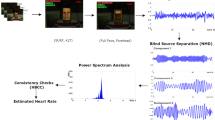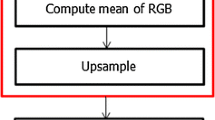Abstract
The vital signs are estimated from remote photoplethysmography (rPPG) using the sparse representation signal reconstruction approach. The rPPG signal is used to estimate the physical parameters with the help of a non-invasive smartphone camera. This paper presents a health monitoring method by estimating vital signs using an RGB video camera and uses a pre-specified dictionary based on a hybrid discrete ridgelet transform with a Ricker wavelet basis function, to reconstruct a sparse signal prone to less error. The physical parameters such as heart rate (HR), breathing rate (BR), heart rate variability (HRV), and SpO2 are estimated using a smartphone video camera with the proposed sparse signal reconstruction technique. The inter-beat intervals (IBIs) are used to extract the power ratio in the frequency domain. Changes in HRV are more discriminative indicators of cognitive stress than those in HR and BR. The physiological states such as stress and fatigue could be measured using IBIs ratio in the frequency domain. The morning and evening dataset sessions are recruited for this experiment to check the stress and fatigue factors based on the power ratio extracted from the IBI signal. In the results, a lower mean absolute probability error value shows that the proposed method produces better results than state-of-the-art methods.








Similar content being viewed by others
References
McDuff D, Gontarek S, Picard R (2014) Remote measurement of cognitive stress via heart rate variability. In: 2014 36th annual international conference of the IEEE engineering in medicine and biology society, pp 2957–2960
Tarassenko L, Villarroel M, Guazzi A, Jorge J, Clifton DA, Pugh C (2014) Non-contact video-based vital sign monitoring using ambient light and auto-regressive models. Physiol Meas 35(5):807–831
Kumar M, Veeraraghavan A, Sabharwal A (2015) DistancePPG: Robust non-contact vital signs monitoring using a camera. Biomed Opt Express 6(5):1565
Jeong IC, Finkelstein J (2016) Introducing contactless blood pressure assessment using a high speed video camera. J Med Syst 40(4):77
Couderc J-P et al (2015) Detection of atrial fibrillation using contactless facial video monitoring. Hear Rhythm 12(1):195–201
Poh M-Z, McDuff DJ, Picard RW (2011) Advancements in noncontact, multiparameter physiological measurements using a webcam. IEEE Trans Biomed Eng 58(1):7–11
Tasli HE, Gudi A, den Uyl M (2014) Remote PPG based vital sign measurement using adaptive facial regions. In: IEEE international conference on image processing (ICIP) vol 2014, pp 1410–1414
Bousefsaf F, Maaoui C, Pruski A (2013) Remote assessment of the heart rate variability to detect mental stress. In: Proceedings of the ICTs for improving patients rehabilitation research techniques
Liu S, Yuen PC, Zhang S, Zhao G (2016) 3D Mask Face Anti-spoofing with Remote Photoplethysmography, pp 85–100
de Haan G, Jeanne V (2013) Robust pulse rate from chrominance-based rPPG. IEEE Trans Biomed Eng 60(10):2878–2886
de Haan G, van Leest A (2014) Improved motion robustness of remote-PPG by using the blood volume pulse signature. Physiol Meas 35(9):1913–1926
Wang W, den Brinker A, Stuijk S, de Haan G (2016) Algorithmic principles of remote-PPG. IEEE Trans Biomed Eng, pp 1–1
Wang W, Stuijk S, de Haan G (2016) A novel algorithm for remote photoplethysmography: spatial subspace rotation. IEEE Trans Biomed Eng 63(9):1974–1984
Wang W, den Brinker AC, Stuijk S, de Haan G (2017) Color-distortion filtering for remote Photoplethysmography. In: 2017 12th IEEE international conference on automatic face & gesture recognition (FG), 2017, pp 71–78
Liu S, Liu D, Zhang J, Zeng Y (2011) Extraction of fetal electrocardiogram using recursive least squares and normalized least mean squares algorithms. In: 2011 3rd international conference on advanced computer control, pp 333–336
Han H, Kim J (2012) Artifacts in wearable photoplethysmographs during daily life motions and their reduction with least mean square based active noise cancellation method. Comput Biol Med 42(4):387–393
Torres J MM, Ghosh A, Stepanov EA, Riccardi G (2016) Heal-T: an efficient PPG-based heart-rate and IBI estimation method during physical exercise. In: 2016 24th European signal processing conference (EUSIPCO), pp 1438–1442
Temko A (2015) Estimation of heart rate from photoplethysmography during physical exercise using Wiener filtering and the phase vocoder. In: 2015 37th annual international conference of the IEEE engineering in medicine and biology society (EMBC), pp 1500–1503
Zhang X, Ding Q (2017) Respiratory rate estimation from the photoplethysmogram via joint sparse signal reconstruction and spectra fusion. Biomed Signal Process Control 35:1–7
Gorodnitsky IF, Rao BD (1997) Sparse signal reconstruction from limited data using FOCUSS: a re-weighted minimum norm algorithm. IEEE Trans Signal Process 45(3):600–616
Zhang X, Ding Q (2016) Respiratory rate monitoring from the photoplethysmogram via sparse signal reconstruction. Physiol Meas 37(7)
Zhang Z, Pi Z, Liu B (2015) TROIKA: a general framework for heart rate monitoring using wrist-type photoplethysmographic signals during intensive physical exercise. IEEE Trans Biomed Eng 62(2):522–531
Qayyum A, Malik AS, Nuafal M, Mazher M, Ahmad RF, Abdullah MF (2015) Evaluation of optimization algorithms for sparse and redundant dictionaries. IEEE Stud Symp Biomed Eng Sci 2015:128–133
Zhang Z (2015) Photoplethysmography-based heart rate monitoring in physical activities via joint sparse spectrum reconstruction. IEEE Trans Biomed Eng 62(8):1902–1910
Rao BD, Engan K, Cotter SF, Palmer J, Kreutz-Delgado K (2003) Subset selection in noise based on diversity measure minimization. IEEE Trans Signal Process 51(3):760–770
Pati Y C, Rezaiifar R, Krishnaprasad PS Orthogonal matching pursuit: recursive function approximation with applications to wavelet decomposition. In: Proceedings of 27th Asilomar conference on signals, systems and computers, pp 40–44
Davenport MA, Wakin MB (2010) Analysis of orthogonal matching pursuit using the restricted isometry property. IEEE Trans Inf Theory 56(9):4395–4401
Cai TT, Wang L (2011) Orthogonal matching pursuit for sparse signal recovery with noise. IEEE Trans Inf Theory 57(7):4680–4688
Sungjun K, Hyunseok K, Kwang SP (2012) Validation of heart rate extraction using video imaging on a built-in camera system of a smartphone. In: Annual international conference of the IEEE engineering in medicine and biology society 2012, pp 2174–2177
Viola P, Jones MJ (2004) Robust real-time face detection. Int J Comput Vis 57(2):137–154
Phung SL, Bouzerdoum A, Chai D (2002) A novel skin color model in YCbCr color space and its application to human face detection. In: Proceedings of international conference on image processing, vol 1, pp I-289-I-292
McDuff D, Blackford E, Estepp J (2017) Fusing partial camera signals for non-contact pulse rate variability measurement. IEEE Trans Biomed Eng, pp 1–1
Aznaveh M M, Mirzaei H, Roshan E, Saraee M.H (2009) A new and improved skin detection method using mixed color space, pp 471–480
Wang W, den Brinker AC, Stuijk S, de Haan G (2017) Robust heart rate from fitness videos. Physiol Meas 38(6):1023–1044
Wiede C, Richter J, Hirtz G (2016) Signal fusion based on intensity and motion variations for remote heart rate determination. In: IEEE international conference on imaging systems and techniques (IST) 2016, pp 526–531
Siddiqui SA, Zhang Y, Feng Z, Kos A (2016) A pulse rate estimation algorithm using PPG and smartphone camera. J Med Syst 40(5):126
Scully CG et al (2012) Physiological parameter monitoring from optical recordings with a mobile phone. IEEE Trans Biomed Eng 59(2):303–306
Baheti PK, Garudadri H (2009) An ultra low power pulse oximeter sensor based on compressed sensing. In: Sixth international workshop on wearable and implantable body sensor networks 2009, pp 144–148
Castells F, Laguna P, Sörnmo L, Bollmann A, Roig JM (2007) Principal component analysis in ECG signal processing. EURASIP J Adv Signal Process 1:74580
Tobaldini E, Nobili L, Strada S, Casali KR, Braghiroli A, Montano N (2013) Heart rate variability in normal and pathological sleep. Physiol Front
Vicente J, Laguna P, Bartra A, Bailón R (2016) Drowsiness detection using heart rate variability. Med Biol Eng Comput 54(6):927–937
Patel M, Lal SKL, Kavanagh D, Rossiter P (2011) Applying neural network analysis on heart rate variability data to assess driver fatigue. Expert Syst Appl 38(6):7235–7242
Qayyum A, Razzak I (2020) Deep residual neural network for child’s spontaneous facial expressions recognition. In S+ SSPR, pp 282-291
Qayyum A, Razzak I, Mumtaz W (2020) Hybrid deep shallow network for assessment of depression using electroencephalogram signals. In: International conference on neural information processing, pp 245–257. Springer, Cham
Rehman A, Naz S, Razzak I (2021) Leveraging big data analytics in healthcare enhancement: trends, challenges and opportunities. Multimed Syst, pp 1–33
Razzak MI, Imran M, Xu G (2020) Big data analytics for preventive medicine. Neural Comput Appl 32(9):4417–4451
Author information
Authors and Affiliations
Corresponding author
Additional information
Publisher's Note
Springer Nature remains neutral with regard to jurisdictional claims in published maps and institutional affiliations.
Rights and permissions
About this article
Cite this article
Qayyum, A., Mazher, M., Nuhu, A. et al. Assessment of physiological states from contactless face video: a sparse representation approach. Computing 105, 761–781 (2023). https://doi.org/10.1007/s00607-021-01028-3
Received:
Accepted:
Published:
Issue Date:
DOI: https://doi.org/10.1007/s00607-021-01028-3




